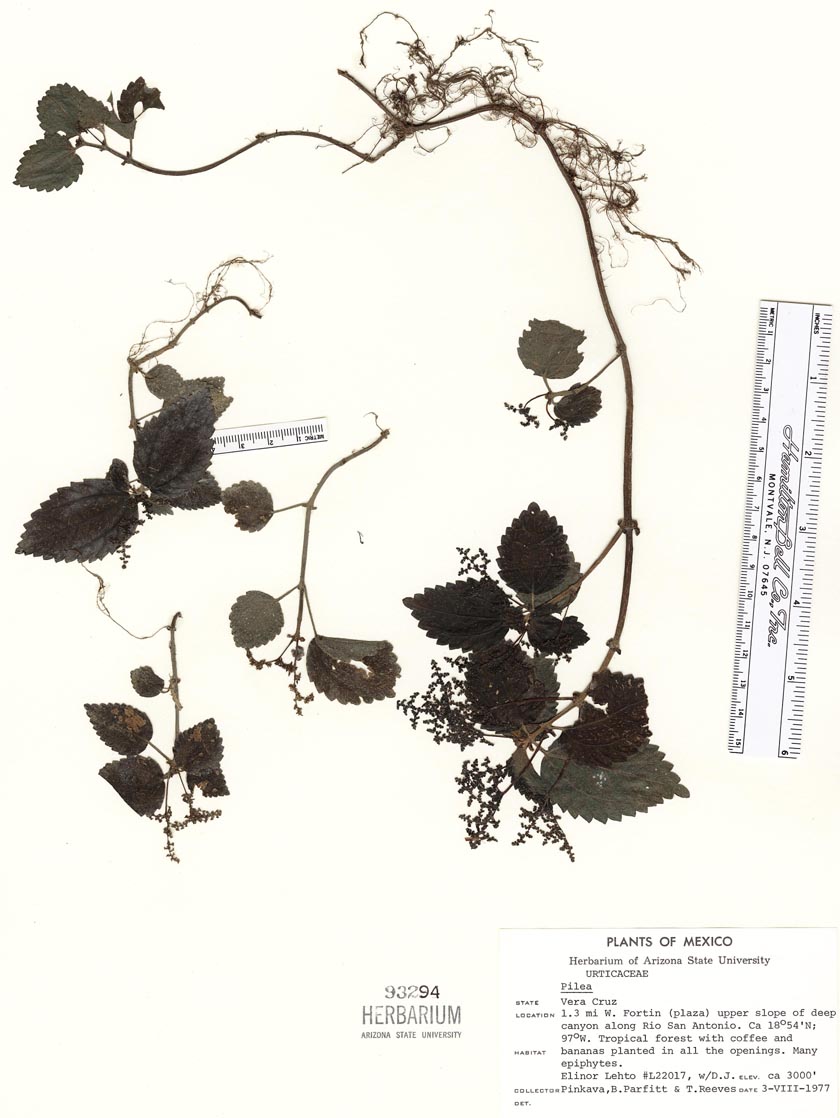Urticaceae
|
Urticaceae |
|
|
Herbs or small shrubs [lianas, trees], herbs annual or rhizomatous perennial, usually pubescent, sometimes with stinging hairs, deciduous. Leaves opposite or alternate and spirally arranged, simple; stipules present or absent; petioles present. Leaf blades paired, equal in size (except in Pilea , which may have unequally paired leaves), dotted with linear or rounded marks formed by cystoliths (variously shaped calcium carbonate crystals inside epidermal cells). Inflorescences axillary or terminal, of paniculately or racemosely arranged cymes, or spikelike. Flowers bisexual or unisexual (staminate or pistillate), staminate and pistillate flowers on same or different plants; perianth hypogynous. Staminate flowers usually pedicellate; tepals 4-5, white or green; stamens 4-5, equaling tepals in number; filaments inflexed in bud, reflexing suddenly as flowers open; anthers basifixed, dehiscing by longitudinal slits; pollen ejected explosively; pistillode 1. Pistillate flowers usually sessile; tepals 2-4, hypogynous, greenish or reddish, distinct or connate; staminodes present or absent; pistil1, 1-locular; placentation basal; ovule1; style present or stigma sessile; stigma linear [capitate]; Bisexual flowers: tepals 4; stamens4; pistil1. Fruits achenes, free or loosely or tightly surrounded by persistent, accrescent perianth. Cystoliths cause patterns on epidermal surfaces. Forms of the cystoliths given in descriptions are readily discernible from surface patterns. Stinging hairs in Urticaceae have a distinct bulbous or cylindric base and a stiff, translucent apex. Nonstinging hairs are soft and flexible and lack a bulbous or cylindric base. The compounds producing the stinging sensation caused by contact with some members of Urticaceae have been reported to be histamine, acetylcholine, 5-hydroxytryptamine, and, in extracts from which the other three have been removed, an unknown substance that produces pain (E. L. Thurston and N. R. Lersten 1969). E. L. Thurston (1969) was not able to find these compounds in Urtica chamaedryoides using analytic techniques, but J. M. Kingsbury (1964, p. 67) reported that the same species '...contains toxicologically significant amounts of acetylcholine and histamine.' The tip of the stinging hair breaks off upon slight contact, leaving a sharp point that readily pierces skin and allows fluid contents of the hair to enter flesh through the body of the hair, which acts as a miniature hypodermic needle. Economically the Urticaceae are most important for their fibers (see D. W. Woodland 1989). They can be troublesome weeds (species of Urtica and Parietaria ), pot herbs (species of Pilea in the tropics, of Urtica in temperate zones), and frequently cultivated ornamentals ( Pilea ) (I. Friis 1993).
PLANT: Monoecious, dioecious, or polygamous, fibrous‑ or taprooted annual or rhizomatous perennial herbs or small shrubs or trees, usually hairy, sometimes with stinging hairs. LEAVES: stipulate or estipulate, petiolate, deciduous, simple, opposite or alternate, the blades with linear or punctiform cystoliths. INFLORESCENCE: of paniculately or racemosely arranged cymes, or spikelike, axillary or terminal; monoecious plants with the staminate and pistillate flowers in the same or in separate inflorescences. FLOWERS: hypogynous, mostly actinomorphic. STAMINATE FLOWERS: usually pedicellate, white or green; tepals and stamens 4 or 5; filaments inflexed at first and eventually ejecting the pollen explosively; pistil rudimentary. PISTILLATE FLOWERS: usually sessile, greenish or reddish; tepals 2‑4; staminodia present or absent; style 1 or absent; stigma linear; ovule 1, basal. PERFECT FLOWERS: with 4 tepals and 4 stamens. FRUIT: an achene, free, either loosely or tightly surrounded by the persistent and accrescent perianth. NOTES: Ca. 40 genera, 900 spp., chiefly tropical and subtropical. REFERENCES: Boufford, David E. 1992. Urticaceae. Ariz.-Nev. Acad. Sci. 26(1)2. |
|
